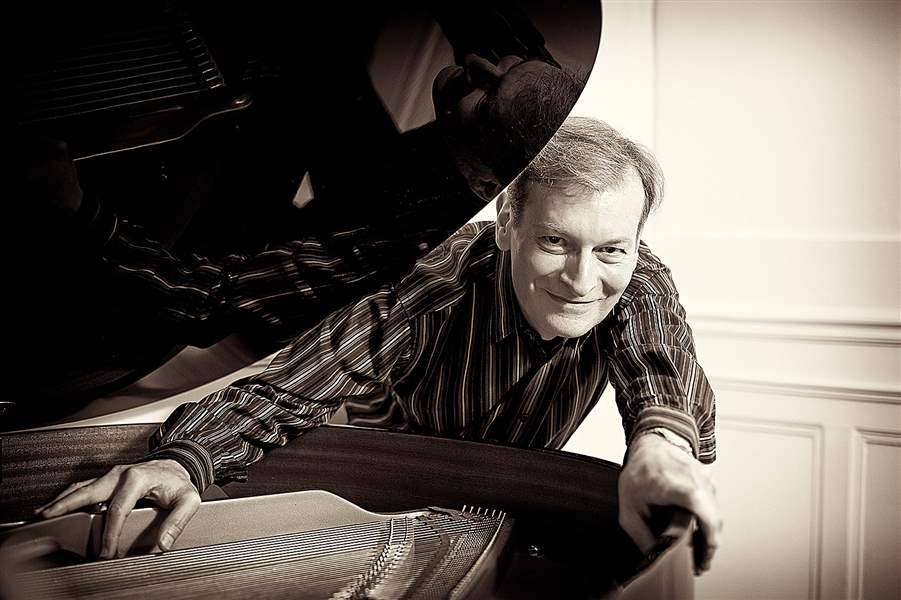
SYMPHONY
Rachmaninoff’s Concerto No. 3 is a testimony to perseverance for pianist Philippe Bianconi
9/18/2013
French pianist Philippe Bianconi will perform with the Toledo Symphony to kick off the Classics Series season at the Peristyle.

French pianist Philippe Bianconi will perform with the Toledo Symphony to kick off the Classics Series season at the Peristyle.
Philippe Bianconi, the internationally renowned French pianist, has a message that should be music to the ears of both long-suffering teachers and their struggling students: Never give up working on a piece.
No matter how difficult it is, with diligent practice and determination, the music will become yours — if you keep on studying.
The proof awaits audiences at the Toledo Symphony’s opening Classics Series concerts this weekend, 8 p.m. Friday and Saturday in the Toledo Museum of Art Peristyle.
In his Toledo debut, Bianconi will perform what is widely considered the most difficult piano work in the entire repertoire: Rachmaninoff’s Concerto No. 3.
“When I started to learn it years ago, I thought I would never be able to play it,” Bianconi wrote The Blade in an email from his home in France. “And it took me a very, very long time before I had the nerves to perform it.
“Rach 3 is not only the longest (40 minutes), but also the most powerful, the largest in scope, and technically, certainly, the most difficult of them all,” added the pianist, who regularly performs the three most well-known of Russian composer Sergei Rachmaninoff’s five piano concertos.
Bianconi’s admission sounds refreshingly honest from a performer who could easily hide behind critical accolades and important awards and, perhaps, play less challenging works.
After winning the Silver Medal in the Seventh Van Cliburn International Competition, he made an acclaimed recital debut at Carnegie Hall in 1987. He was the 1981 first prize winner in the Cleveland International Piano Competition, back when it was still affiliated with the Robert Casadesus organization.
(Casadesus (1899-1972) was the towering figure among French pianists; Bianconi studied with his wife and performing partner, Gaby Casadesus.)
Bianconi, 53, has earned raves in both orchestral and solo performances. A recent recital in the Théâtre des Champs-Elysées in Paris had critics dubbing him "the premiere pianist of France." He has performed with top orchestras and conductors in Europe and the U.S.
Known for his artful way with Impressionist composers such as Ravel and Debussy, both live and in several recordings, Bianconi will reveal more dramatic chops in Toledo in an all-Rachmaninoff program led by principal conductor Stefan Sanderling.
“It is also the most complex of all Rachmaninoff concertos,” Bianconi wrote. “It’s saturated with intoxicating harmonies and very thick pianistic textures, that make you feel you never have enough fingers!” He now directs the American Conservatory at Palais de Fontainebleau.
“One of the most striking features of this concerto is the simple, quiet, and beautiful first theme introduced by the piano at the beginning, sounding like an Orthodox chant. When you first hear this theme, it is impossible to imagine the potential it contains,” Bianconi noted.
“Playing this concerto is always an exhilarating experience, for the performers as well as for the audience.”
Starting off its 70th anniversary season with a demanding concert is just right for the Toledo Symphony. Born during the dark days of World War II, Toledo’s stalwart orchestra has persevered and grown and flourished ever since.
Since Sanderling joined the organization 11 years ago, programming has grown more innovative and brought national and international recognition to the Toledo symphony as an outstanding regional group.
But that’s not enough for Sanderling, who spoke at Toledo Rotary on Monday, and discussed an ambitious vision for the orchestra.
“I want to make the Toledo Symphony the best orchestra in the world. Only this high goal will allow us to keep music alive in the community.”
Citing the ongoing saga of struggling and failing orchestras around the U.S., Sanderling stated firmly, “Orchestras are more needed than ever before.”
Supporting an orchestra is a health issue for the community, he said. “When the orchestra — and other arts organizations — are doing well, we will have created a healthy community.”
This season promises a continuation of his creative and collaborative approach to live music that took the Toledo Symphony to Carnegie Hall in 2011.
Ahead on the Classics series are programs combining theater and music, including the Oct. 18-19 concerts when H.K Gruber’s work, Frankenstein!!, subtitled A Pan-Demonium for Chansonnier & Ensemble, will bring the classic Mary Shelley terror tale to life in music.
In February, the partnership forged for the Carnegie program will bring the Peter Shaffer play, “Amadeus,” to the Peristyle with music by the Mozart.
There is a two-concert set Feb. 28 and March 1 called The Brahms Project, two different programs featuring both of the composer’s piano concertos, performed by pianist Kirill Gerstein.
And, the biggest breakthrough will be April 6, when the symphony sets up inside Huntington Center for the biggest production of Beethoven’s Symphony No. 9 ever in Toledo, complete with a choir of 1,000 young voices.
Still, a musical journey begins like all treks, with the first step.
And that will happen Friday and Saturday in a program which also includes Shostakovich’s lyrical Symphonic Dances.
Bianconi, Sanderling, and the symphony's seasoned players will be there, waiting to start the climb to brighter musical stardom. They are hoping the community will be there to support their effort.
Tickets are $22-52 at 419-246-8000 or toledosymphony.com.